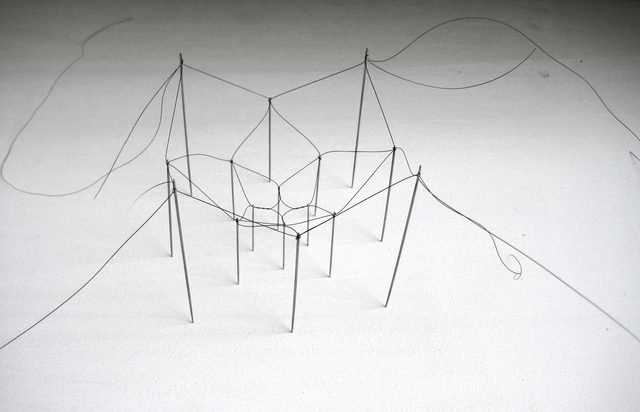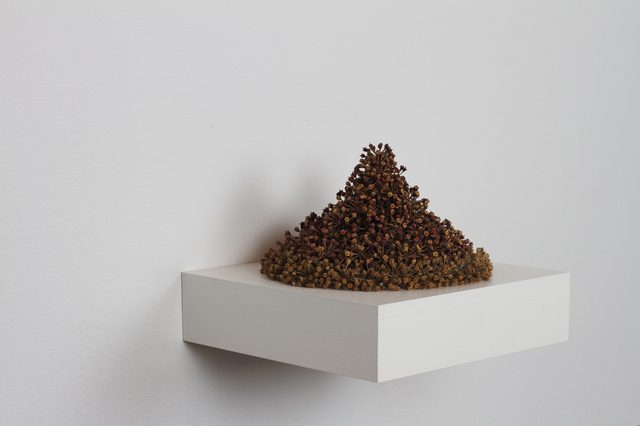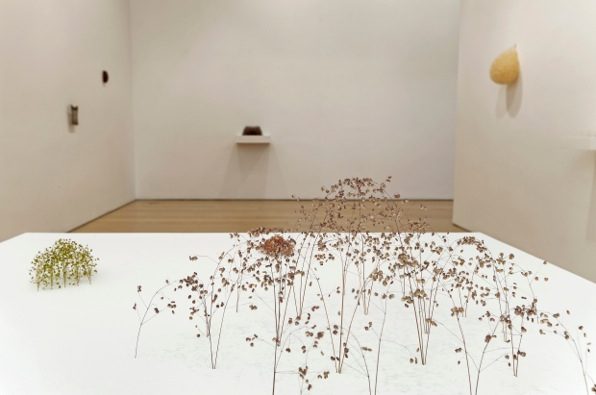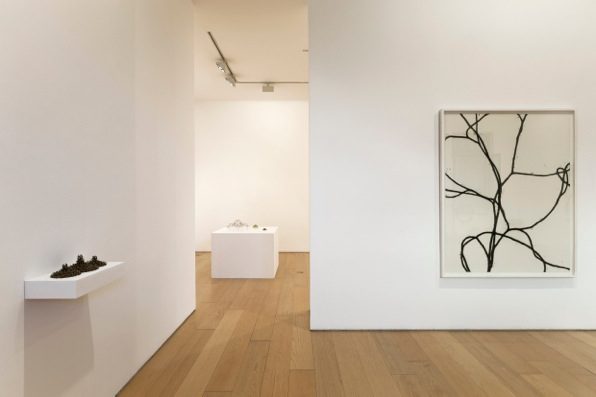INTERVIEW: Christiane Lӧhr
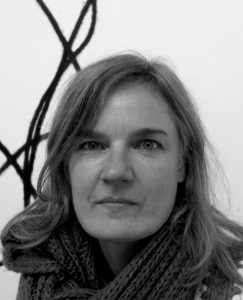 The series of works by German artist Christiane Lohr, at the Bernier/Eliades Gallery, is emotional… and touches deeply, because with the simplest materials from nature, creates a series of small-scale sculptures delicate and sensitive externally, but internally embody the insurmountable power of nature, with a visual language and semiotics: pure, robust and full bodied. While her drawing, where white is the basic color, is a detail of infinity… as she explains to us. She made her Master degree at the Fine Arts School in Düsseldorf, with professor Jannis Kounellis though it seems to have been influenced by her teacher in Arte Povera and Land Art,this is only theoretical, since she clarifies us, that that: makes sculpture and indeed with the classic definition of the term.
The series of works by German artist Christiane Lohr, at the Bernier/Eliades Gallery, is emotional… and touches deeply, because with the simplest materials from nature, creates a series of small-scale sculptures delicate and sensitive externally, but internally embody the insurmountable power of nature, with a visual language and semiotics: pure, robust and full bodied. While her drawing, where white is the basic color, is a detail of infinity… as she explains to us. She made her Master degree at the Fine Arts School in Düsseldorf, with professor Jannis Kounellis though it seems to have been influenced by her teacher in Arte Povera and Land Art,this is only theoretical, since she clarifies us, that that: makes sculpture and indeed with the classic definition of the term.
By: Dimitris Lempesis & Efi Michalarou
Photo: Bernier/Eliades Gallery Archive
When you started to observe the nature and involve it in your work?
When I was 18 years old I won a horse and from that horse I was for 25 years in direct contact with nature. Going there every day, observing changings of nature, and this happened while I was studying art. Slowly it all came in to my work and began to be in materialistic terms, and in observation of place and space, it came in to my work.
Your work has references to Land Art and Arte Povera your artwork is fine sensitive and of small dimensions.
When I started, I discovered Land Art, and the Arte Povera in books and catalogues, and it was opening my horizon. I could understand that everything can go into art, and everything I decide can be art. All of the things of my life, this is what I learnt from observing these movements. About the size of my work, it is really very small, and it’s small because my material is small, and I don’t want to blow it up. I am not interested in that. It’s like a having certain tension and I need to stay in a proportion. Very often, it is a very small format, in the beginning, it was disappointing me, but now I can accept it also, I can accept that my work has no contradictions and elations, you cannot relate it to the format. It’s something different from Land art. It is very similar, but it is very different, because it is small.
Maybe changes the methodology and the perceptual of space...
I think the work does not have to do with Land Art, because Land Art was quite often a very violent intervention into space and into landscape. In a way, I am doing sculpture. It is a very classical idea of working. It is a different thing.
Living in an era that the artist, more and more use the technology to produce their work. You are working with natural elements, let us say, half in the studio, half in nature – collecting your materials. How important it is for you to work in nature?
I do not work in nature. I am taking my material and, sometimes, I think it is not so important. It is like when the painter goes to buy the paint. People have an image that it is very holy when I go to take my material, but it is not like that. It can happen on the way to the studio, or quite often, I go with a precise idea of what I need. However, it is not so heavy, it is not so full of significance to take it. It is not romantic.
It is not necessarily romantic.
No, but it is funny that people have very strange ideas. They think I am living in the forest.
Yes, but it is another side of modern people. It is not a romantic side – it is a normal side, because you told me, you have an apartment – a house – in Cologne at the center of the city and a house in Prato-Tuscany close to nature. These are two different things, many of us, have two sides.
It is also very interesting that I can find my material not in the intact nature, but mostly in the periphery, and mostly in places where civilization and nature are in friction. In abandoned places or the periphery of the city, and this is very interesting.
Do you consider your work close to Arte Povera or post-Arte Povera?
No, but it is like what I was saying before, knowing Arte Povera, it was as if it was opening my idea of art, as I told you before, I had a horse… I had seen photos of the “Twelve Horses” of Jannis Kounelis in the Gallery. It was really fascinating me, and from that I had the wish to study with him, but my work is not Arte Povera. It does not have to do with it. However, I am fascinated by what the artist have done with their time. It is sculpture. It is another thing.
Moreover, the drawings how arise?
I like the papers. I love the papers. I love the black and white because I do not care about color but only for the form.
The drawings are continuity of your work or act as notes?
No, they are not notes. With cutwork and with the drawing, I am much freer. You have no limits and that is exciting for me.
The feeling that gives me the white is very strange, because it is large, white encapsulates us…Why do you use white?
Because it is without limits. It is unlimited… is very important. It is like our connection with the universe. It is a very strange feeling.
I think white is very difficult color.
It is a detail of infinity…
First Publication: www.dreamideamachine.com
© Interview – Dimitris Lempesis & Efi Michalarou
Info: Bernier/Eliades Gallery, 11 Eptachalkou Str., Thisio, Athens, Duration: 20/11/14-8/1/15, Days & Hours: Tue-Fri: 10:30-18:30, Sat: 12:00-16:00, http://bernier-eliades.gr
